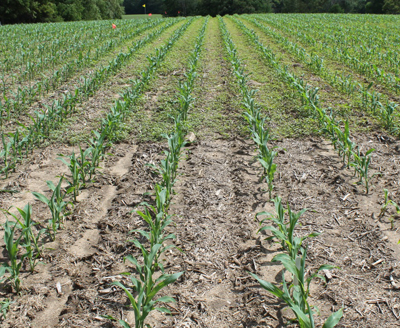
- Rapid planting progress may have resulted in some acres not receiving a preemergence herbicide.
- There are still several options in corn and soybeans to provide early postemergence residual control.
- Strongly consider an early postemergence residual on these acres as resistant weeds and environmental conditions may increase risk and result in reduced yields if weeds are allowed to compete with the emerged crop.
With the rapid planting progress and a few wet periods (or windy conditions) over much of the region, some of our intended preemergence herbicide applications were unable to be applied prior to crop emergence. While these previous plans were formed with the best weed management practices in mind, all is not lost when the crop emerges. There are many options in both corn and soybeans that will provide control of emerged weeds as well as residual for later emerging weed flushes. Consider using a postemergence herbicide with residual sooner rather than later. With moist soils and the prospect of warmer temperatures in the forecast, rapid germination and growth of weeds may be in our near future. The sooner we address these flushes of weeds, the less likely they are to cause yield reductions to our corn and soybeans. Also, the timely rains and higher than optimal winds that reduced our capacity to apply all of the preemergence herbicides may return when we intend to spray our postemergence herbicides. Applying a postemergence herbicide with residual now will help ensure timely application to emerged weeds.
First, here are watch outs when applying residual herbicides in emerged corn:
- Avoid tank mixes with 2,4-D shortly prior-to or just after planting. Rainfall after 2,4-D application can move the 2,4-D into the seed germination zone, resulting in germination issues and possible “corkscrewing” of the mesocotyl. If 2,4-D is needed in the mix, the best bet is to wait until after corn emergence.
- Check your residual corn herbicide labels carefully. Many of the common products have either an 11 inch or 12 inch height restriction. Be sure you know which-is-which.
- BE CAUTIOUS about applications of any corn residual herbicides in UAN nitrogen solution, since this can increase the risk of crop injury.
Second, here are a few considerations when applying residual herbicides in emerged soybeans:
- Programs for control of pigweeds will most likely include the use of PPO-inhibiting (Group 14) herbicides such as Cobra or Flexstar for glyphosate-resistant biotypes. Glufosinate can be used in Liberty soybeans and approved dicamba products can be used in Roundup Xtend soybeans.
- Residual herbicides for soybeans may include ALS-inhibitors (Group 2) or more commonly, Long-Chain Fatty Acid inhibitors (Group 15). Group 15 herbicides are most effective for providing residual control of waterhemp in emerged soybeans. If ALS resistant species are present, focus on Group 15 herbicides.
- Consider adjuvant usage when applying herbicide tank-mixtures. Many times PPO inhibitors recommend oil-based adjuvants while the residual herbicide in the mixture may not recommend oil based adjuvants. Many EC formulations may “heat up” contact herbicides when an oil-based adjuvant is used. In these instances, Nonionic surfactant may be more suitable. Also, check the manufacturer websites for approved adjuvants with XtendiMax, FeXapan, and Engenia and remember to never use AMS with these products.
Lastly, refer to the herbicide label prior to using any herbicide to ensure proper application.
Image: Value of early postemergence herbicide application (front of picture) versus waiting to apply until late postemergence (back of picture).